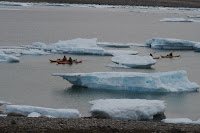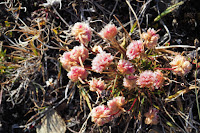 |
| Ready for the next adventure |
Another bright and sunny day, we continued south into Prince Regent Inlet and to the eastern entrance to Bellot Strait.
The historic site of Fort Ross located on the southern end of Somerset Island was home to a former Hudson’s Bay Company fur trading outpost, as well as archaeological sites dating back over a thousand years.
The historic site of Fort Ross located on the southern end of Somerset Island was home to a former Hudson’s Bay Company fur trading outpost, as well as archaeological sites dating back over a thousand years.
 |
| Kayakers already in the water |
Meantime our stalwart companions who had signed up for the kayak program set off to explore the coastline.
 |
| Obstacle course for the zodiacs |
 |
| Abandoned HBC outpost |
Safely aboard, we edged our way from ship to shore through gaps in the ice, many
chunks of which were grounded and sitting high in the water, taking on the
appearance of oversized piecrusts.
 Clambering on the rocky shore, now equipped with sturdy walking poles, we climbed up the beach to the abandoned HBC buildings, one the former trading post, the other the living quarters of the station manager and his wife, Mr. and Mrs. Heslop.
Clambering on the rocky shore, now equipped with sturdy walking poles, we climbed up the beach to the abandoned HBC buildings, one the former trading post, the other the living quarters of the station manager and his wife, Mr. and Mrs. Heslop.
 A climb around the perimeter of the buildings revealed the multi-coloured lichen growing on the reddish rocks. Occasionally there would be the odd rock strewn around that appeared uncharacteristic to the landscape. Known as "erratics" these particular rocks had been deposited by the glaciers.
A climb around the perimeter of the buildings revealed the multi-coloured lichen growing on the reddish rocks. Occasionally there would be the odd rock strewn around that appeared uncharacteristic to the landscape. Known as "erratics" these particular rocks had been deposited by the glaciers.
While the Heslops' living quarters looked like they had been reasonably cozy at one time, through the broken windows the rusty frames of easy chairs and peeling wallpaper told the story. A dilapidated coffee pot sat on the pot bellied stove along with two rusting metal mugs, somehow frozen in time.
It must have been a solitary life and its hard to imagine being assigned to this wilderness and finding that after almost three years the much anticipated supply ship was still unable to reach Fort Ross because of packed ice.
After an emergency meeting at HBC headquarters in Winnipeg in 1943 it was decided to evacuate the outpost by air. This had never been attempted in this part of the Arctic before and finding no suitable aircraft for the mission in Canada, HBC contacted the U.S. military.
 Clambering on the rocky shore, now equipped with sturdy walking poles, we climbed up the beach to the abandoned HBC buildings, one the former trading post, the other the living quarters of the station manager and his wife, Mr. and Mrs. Heslop.
Clambering on the rocky shore, now equipped with sturdy walking poles, we climbed up the beach to the abandoned HBC buildings, one the former trading post, the other the living quarters of the station manager and his wife, Mr. and Mrs. Heslop. A climb around the perimeter of the buildings revealed the multi-coloured lichen growing on the reddish rocks. Occasionally there would be the odd rock strewn around that appeared uncharacteristic to the landscape. Known as "erratics" these particular rocks had been deposited by the glaciers.
A climb around the perimeter of the buildings revealed the multi-coloured lichen growing on the reddish rocks. Occasionally there would be the odd rock strewn around that appeared uncharacteristic to the landscape. Known as "erratics" these particular rocks had been deposited by the glaciers.While the Heslops' living quarters looked like they had been reasonably cozy at one time, through the broken windows the rusty frames of easy chairs and peeling wallpaper told the story. A dilapidated coffee pot sat on the pot bellied stove along with two rusting metal mugs, somehow frozen in time.
It must have been a solitary life and its hard to imagine being assigned to this wilderness and finding that after almost three years the much anticipated supply ship was still unable to reach Fort Ross because of packed ice.
After an emergency meeting at HBC headquarters in Winnipeg in 1943 it was decided to evacuate the outpost by air. This had never been attempted in this part of the Arctic before and finding no suitable aircraft for the mission in Canada, HBC contacted the U.S. military.
 The
result was the first parachute jump in the Canadian Arctic. Air Force Captain Stamwell-Fletcher jumped
out of the aircraft, the aim being to find a suitable landing site. This was his first parachute jump after only
one day of instruction.
The
result was the first parachute jump in the Canadian Arctic. Air Force Captain Stamwell-Fletcher jumped
out of the aircraft, the aim being to find a suitable landing site. This was his first parachute jump after only
one day of instruction. Apparently he did it in style, somersaulting in the air and upon landing bowing as he greeted the station manager’s wife with “Mrs Heslop, I presume”. A potential runway was found on the surface of a frozen lake ten miles away from the outpost and the site was hastily evacuated. The Heslops were told to leave everything behind, hence the interesting array of decaying items strewn around their dwelling, victims of the howling winds and relentless weather.
A
wild and uninviting landscape with a bit of a romantic back story.


No comments:
Post a Comment